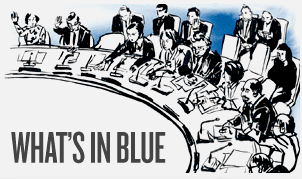Briefing and Presidential Statement on UNOCA and LRA
On Monday (12 May), Abou Moussa, the outgoing Special Representative of the Secretary-General and head of the UN Regional Office for Central Africa (UNOCA), will brief the Council on the Secretary-General’s report on UNOCA and the regional strategy on the Lord’s Resistance Army (LRA) (S/2014/319). The report was requested by a presidential statement adopted on 25 November (S/PRST/2013/18), following the Council’s last briefing on UNOCA and the LRA on 20 November (S/PV.7065). Abdoulaye Bathily, whose appointment as head of UNOCA was announced by the Secretary-General on 30 April, is also anticipated to attend. A presidential statement on the LRA is expected to be adopted.
In terms of the threat posed by the LRA, recent trends appear to be positive. According to the Office for the Coordination of Humanitarian Affairs (OCHA), the number of people displaced in “LRA-affected areas” of the Central African Republic (CAR), the Democratic Republic of Congo (DRC) and South Sudan declined from 326,448 at the end of 2013 to 159,927 within the first three months of 2014. OCHA reported 65 presumed LRA attacks in the CAR and the DRC (but none in South Sudan) during the first quarter of 2014, which resulted in 93 abductions and two deaths. According to the Secretary-General’s report, although Sudan claims there is no LRA presence in the Kafia Kingi enclave at the intersection with CAR, South Sudan and Sudan, credible sources suggest LRA leader Joseph Kony and other senior commanders have returned to the Sudan-controlled enclave in search of a safe haven. By most estimates, the LRA continues to decline in strength—now between 250 to 500 fighters.
Recent developments in the CAR, the DRC, and South Sudan have affected both the availability of territory for the LRA to operate and the number of troops deployed under the auspices of the AU Regional Task Force (AU-RTF). The decrease in displaced persons in LRA-affected territory cited by OCHA has been attributed to the success of AU-RTF operations against LRA bases in Garamba National Park in the DRC. On the other hand, the outbreak of conflict in South Sudan as of 15 December 2013 has resulted in the redeployment of contingents from South Sudan and Uganda, reducing the AU-RTF’s strength from 3,380 to 2,147 (out of 5,030 troops pledged). Meanwhile, continued instability in the CAR provides further opportunity for LRA activity.
Moussa is also likely to discuss the threat posed by Boko Haram to the Central African region. According to the Secretary-General’s report, Boko Haram has recently expanded its operations from northeastern Nigeria into other countries, particularly Cameroon. The escalating conflict between Nigeria and Boko Haram has also affected the humanitarian situation in nearby countries, with an estimated 57,000 refugees and returning immigrants having been forced into Cameroon, Chad and Niger. Numerous sources claim that Boko Haram members also routinely cross into these countries in order to evade capture, while the group had previously established contact in Mali with Al-Qaida in the Islamic Maghreb. These transnational dimensions suggest there may be a need to develop a regional response to what has thus far been primarily an internal conflict.
Moussa’s briefing may also cover regional and transnational criminal threats such as poaching and piracy. Linkages between the illicit wildlife trade and financing for armed groups within Central Africa remain of particular concern, while the Gulf of Guinea has overtaken the Somalia coastline as the region most affected by piracy. Moussa may highlight UNOCA’s work with the Economic Community of Central African States and regional governments to tackle these issues, such as following up on the 24-25 June 2013 summit in Yaoundé, Cameroon on maritime insecurity in the Gulf of Guinea.
The draft presidential statement is predominantly focused on the LRA and the various counter-LRA initiatives of the AU and UN. The text also briefly mentions other security threats such as Boko Haram, piracy, poaching, terrorism and transnational organised crime. The negotiations do not seem to have been contentious, perhaps partly due to substantial reliance on agreed language from the previous presidential statement. As with previous presidential statements on the subject, the text concludes with a request for the Secretary-General to issue another report on UNOCA and the LRA in roughly six months (by 15 November). Given the declining impact of the LRA as a threat to peace and security, coupled with the rise of other regional threats, the next briefing could be an opportunity for the Council to re-evaluate its focus within Central Africa. In addition, with Boko Haram becoming an increasing concern both in Central and West Africa, it may be time for the Council to consider how to address an issue that cuts across these regions.
Follow us on Twitter, LinkedIn and Facebook.

